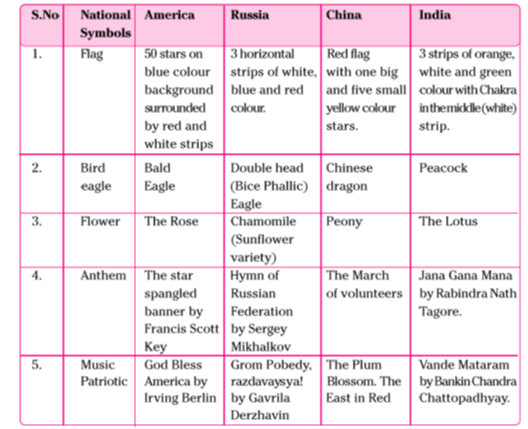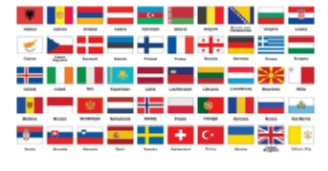Study Material
1. The Rise of Nationalism in Europe

1. Write a note on :
a) Giuseppe Mazzini
b) Count Camillo de Cavour
c) The Greek war of independence
d) Frankfurt Parliament
e) The role of women in nationalist struggles
A. a) Giuseppe Mazzini : He was an Italian revolutionary, who was born Genoa in 1807 in a middle class family. He was sent into exile at the age of 24 in 1831 for attempting a revolution in Liguria. He was a member of the secret society of the Carbonari. To involve the youth in revolutionary activities, he founded the underground secret societies named 'Young Italy' in Marseilles and 'Young Europe' in Berne, whose members were like-minded young men from Poland, France, Italy and the German states. He believed that God had intended nations to be the natural units of mankind. He opposed monarchy and supported the vision of democratic republics frightened the 'Conservatives'. Following his ideas and on the model of his secret societies more such societies were set up on Germany, France, Switzerland and Poland. These societies helped in the dissemination of his ideas.
b) Count Camillo de Cavour : Cavour was the Chief Minister of Sardinia - Piedmont. He was neither a democratic nor a revolutionary. But he led the movement to unify the regions of Italy. Through a tactful diplomatic alliance with France, he succeeded in defeating Austrian forces in 1859 and thereby freed the Northern part of Italy from the Austrian Habsburg.
c) The Greek war of independence : Greece was a part of the Ottomon empire since the 15th century. The struggle for independence amongst the Greeks began in 1821. It was a successful war waged by Greek revolutionaries between 1821 to 1832 against the Ottoman empire. Greek nationalists were supported by the West European countries in this war of independence. Poets and artists lauded Greece as the cradle of European civilisation. Finally, the Treaty of Constantinople in July 1832, recognised Greece as an independent nation.
d) Frankfurt Parliament : It was the name of the German National Assembly, founded during the Revolution of 1848 that tried to unite Germany in a democratic way. It was formed by the middle class professionals, entrepreneurs, and artisans belonging to the different German regions. The assembly was attended by 831 deputies. The members had drafted the constitution for a new German nation. Friedrich Wilhelm IV of Prussia was chosen emperor but he refused to accept the crown and joined other monarchs. Though the Frankfurt Parliament failed to unite Germany, it had consequences on Germany. The Parliament also faced strong opposition from the aristocracy and military. As result of this, the middle class lost their mass support, ultimately, the monarchy and military combined together with the aristocracy and won over the liberal nationalist middle - class. This forced the assembly to disband.
e) The role of women in nationalist struggles : A large number of women had participated in liberal and national movements in European countries. Women had formed their own political associations, founded newspapers and taken part in political meetings and demonstrations. Despite this, they were denied suffrage during the election of the Assembly. When the Frankfurt Parliament convened in the church of St.Paul, women were admitted only as observers to stand in the visitor's gallery.
2. What steps did the French revolutionaries take to create a sense of collective identity among the French people ?
A. The following steps are taken by French revolutionaries to create a sense of collective identity among the French people :
i) Introduction of ideas of la patrie (the fatherland) and le citoyen (the citizen) emphasising the notion of a united community enjoying equal rights under a constitution.
ii) A new French flag, a tricolour replaced the royal standard.
iii) The Estates General was renamed the National Assembly and was elected by a group of active citizens.
iv) New hymns, oaths and martyrs commemorated, in the name of the nation.
v) A central administration system made uniform laws for the entire nation.
vi) Discouraging regional dialects and promoting French as a common language of the nation.
3. Who were Marianne and Germania ? What was the importance of the way in which they were portrayed ?
A. Marianne and Germania were female allegories invented by artists in the nineteenth century to represent the abstract idea of the nation for the German and French countries, respectively.
The female allegories stood as personifications of the "Republic" and "Liberty". They were portrayed such that would instill a sense of nationality in the citizens of these countries. Marianne was seen in a red cap, the tricolour and the arcade. The statues of Merianne were erected in public squares to remind the public of the national symbol of unity. Germania wears a crown of oak leaves as German oak stands for heroism.
4. Briefly trace the process of German unification.
A. In 1848, the middle class Germans tried to unite the different regions of the German confederation into a nation-state governed by an elected Parliament. But they were repressed by the combined forces of the monarchy and the military, supported by the large landowners of Prussia. After this, Prussia soon became the leader of German Unification movement. Its Chief Minister Otto von Bismark was the architect of the process with support from Prussia army and Prussian bureaucracy. Prussia, under the leadership of Otto von Bismark, emerged as the driving force behind unification. Bismark pursued a policy of Realpolitik, using diplomacy and warfare strategically. The unification process was completed after Prussia won wars with Austria, Denmark and France over seven years time. In January 1871, the Prussian king, William I, was crowned as the German Emperor. It symbolized the birth of a united Germany.
5. What changes did Napolean introduce to make the administrative system more efficient in the teritorries ruled by him ?
A. Napolean had incorporated revolutionary principles to make the adminstrative system more efficient in the territories ruled by him. Some key changes made by him include :
i) The Civil Code of 1804 - usually known as the Napoleonic Code, did away with all privileges based on birth, established equality before law and secured the right to property.
ii) Napoleon simplified administrative divisions.
iii) He abolished the feudal system and freed peasants from serfdom and manorial dues.
iv) In the towns too, guild restrictions were removed.
v) Transport and communication systems were improved. Thus Napoleon Bonaparte introduced several administrative changes in order to make the whole system more rational and efficient.

1. Explain what is meant by the 1848 revolution of the liberals. What were the political, social and economic ideas supported by the liberals ?
A. The 1848 revolution was led by the educated class along with the poor, unemployed starving peasants and workers in Europe. In certain parts of Europe such as Germany, Italy, Poland and the Austro - Hungarian Empire, men and women of the liberal middle classes took advantage of the growing popular unrest to push their demands for the creation of nation - states based on Parliamentary principles.
The political, social and economic ideas supported by the liberals were
Political ideas : Politically, they demanded constitutionalism with national unification. They wanted creation of nation-state on parliamentary principles - a constitution, freedom of the press and freedom of association.
Social ideas : The liberals wanted to rid society of its class-based partialities and birth rights. Serfdom and bonded labour had to be abolished.
Economic ideas : Liberals urged the freedom of markets and right to property. Abolition of state imposed restrictions on the movements of goods and capital.
2. Choose three examples to show the contribution of culture to the growth of nationalism in Europe.
A. Culture played a significant role in fostering the growth of nationalism in Europe. Here are three examples that highlight this contribution.
i) Language and literature : Language played an important role in developing nationalist sentiments. After Russian occupation, the Polish language was forced out of schools and Russian language was imposed everywhere. In 1831, an armed rebellion against Russian rule took place which was ultimately crushed. Following this, many members of the Clergy in Poland began to use language as a weapon of national resistance. Writers and poets began to focus on their native languages to create literary works that celebrated their culture, history and traditions. Romantic artists and poets generally criticized the glorification of reason and science and focussed instead of emotions, intuition and mystical feelings. Their effort was to create a sense of shared collective heritage, a common cultural past, as the basis of a nation.
ii) Art and Visual Representation :- Artistic expressions, including paintings, sculptures, and architecture, were used to symbolize and promote national identity. The French painter Delacroix was one of the most important French Romantic painters. His painting depicts an incident in which 20,000 Greeks were said to have been killed by Turks. By dramatising the incident focussing on the suffering of women and children, and using vivid colours, Delacroix sought to appeal to the emotions of the spectators, and create sympathy for the Greeks and helped to evoke a sense of pride in one's cultural heritage and contributed to the formation of national identities.
iii) Music and Folklore : Music and folk tradition also played a crucial role in nurturing nationalism. Karol Kurpinski, for example, celebrated the national struggle through his operas and music, turning folk dances like the polonaise and mazurka into nationalist symbols.
3. Through a focus on any two countries, explain how nations developed over the nineteenth century.
A. In the 19th century, the two countries Germany and Italy were developed as nations in the following ways :
Unification of Germany : In 1848, an attempt was made to unite different regions of the German confederation into a nation-state governed by an elected parliament. However, this liberal initiative was repressed by the combined forces of the monarchy and the military, who were supported by the large landowners of Prussia. Thereafter, Prussia took on the leadership of the movement for national unification. Its Chief Minister, Otto von Bismark with the help of the Prussian army and bureaucracy in the process. Three wars over seven years with Austria, Denmark and France ended in Prussian victory and completed the process of unification. In January 1871, the Prussian King, William I, was proclaimed as the German emperor in a ceremony held at Versailles.
Unification of Italy : In the middle of the 19th century, Italy was divided into seven states. Of these, only Sardinia - Piedmont was ruled by an Italian princely house. The north was under the Austrian-Habsburg Empire, the centre was ruled by the Pope while the southern regions were dominated by the Bourbon kings of France. Also, the Italian language had many regional and local variations. In the 1830s, Giuseppe Mazzini sought to formulate a coherent programme for a unitary Italian republic and also had established a secret society called Young Italy for the fulfillment of his goals. The revolutionary uprisings in 1831 and 1848 largely failed. Thus, the responsibility of uniting Italian states was now on King Victor Emmanuel II of Sardinia-Piedmont. The Chief Minister of Italy, Cavour led the movement to unify the regions of Italy. He was able to conclude a diplomatic alliance with France. Also, Sardinia - Piedmont succeeded in defeating the Austrian forces in 1859. Apart from regular troops, a large number of armed volunteers, under the leadership of Giuseppe Garibaldi, also joined the movement. In 1860, these troops marched into South Italy and the kingdom of Two Sicilies. These areas were liberated and later joined with Sardinia. In 1870, Rome was vacated by France and it became a part of Sardinia. Finally, Italy was unified in 1871.
These examples illustrate how Italy and Germany developed as unified nations over the 19th century.
4. How was the history of nationalism in Britain unlike the rest of Europe ?
A. The history of nationalism in Britain differed from that of the rest of Europe in several key ways.
In Britain, the formation of the nation-state was not the result of sudden upheaval or revolution. The primary identities of the people who inhabited the British isles were ethnic ones such as English, Welsh, Scot or Irish. All of these ethnic groups had their own cultural and political traditions. But as the English nation steadily grew in wealth, importance and power, it was able to extend its influence over the other nations of the islands.
The Act of Union (1707) between England and Scotland resulted in the formation of, the 'United Kingdom of Great Britain' meant that England was able to impose its influence on Scotland. Scotland's distinctive culture and political institutions were systematically suppressed. The Catholic clans that inhabited the Scottish Highlands suffered terrible repression whenever they attempted to assert their independence and the Scots were banned from speaking their Gaelic language and put on their national dress.
Ireland suffered a similar fate. It was a country deeply divided between Catholics and Protestants. The English helped the Protestants of Ireland to establish their dominance over a largely Catholic country. Catholic revolts against British dominance was suppressed. Ireland was forcibly incorporated into the United Kingdom in 1801. The symbols of new Britain, the British flag, the national anthem, the English language were actively promoted and the older nations survived only as subordinate partners in this union.
5. Why did nationalist tensions emerge in the Balkans ?
A. Nationalist tension emerged in the Balkans because Balkan states were aspiring for nationalism. It consisted of modern-day Albania, Greece, Romania, Bulgaria, Macedonia, Croatia, Bosnia, Slovenia, Serbia, Herzegovina and Montenegro. In 19th century, the major portion of the Balkans was under the Ottoman Empire. The ideas of romantic nationalism developed in the Balkans. The rebellions nationalities in the Balkans thought that their struggle was the attempt to win back their long-lost independence.
H Find out more about nationalist symbols in countries outside Europe. For one or two countries, collect examples of pictures, posters or music that are symbols of nationalism. How are these different from European examples ?
A. Some of the nationalist symbols of the countries other than European countries are as under :

These nationalist symbols are very different from the symbols of European countries in the manner that they manifest nationalist sentiments of their respective countries.
Images showing the difference between the flag of Europeans and others.

